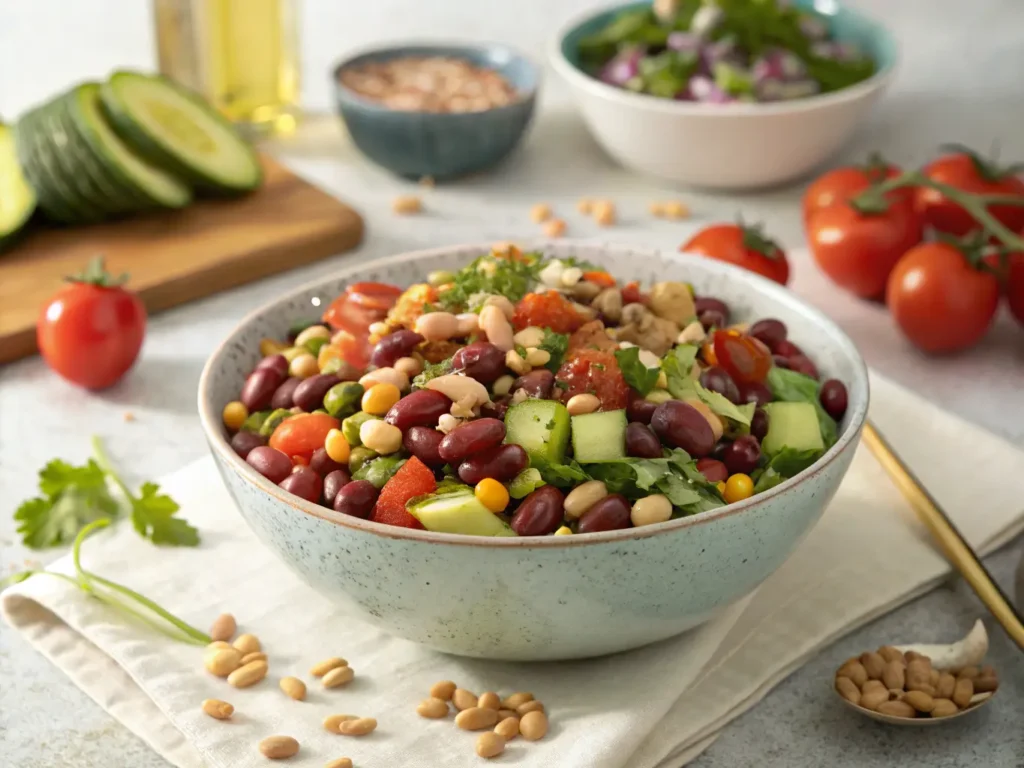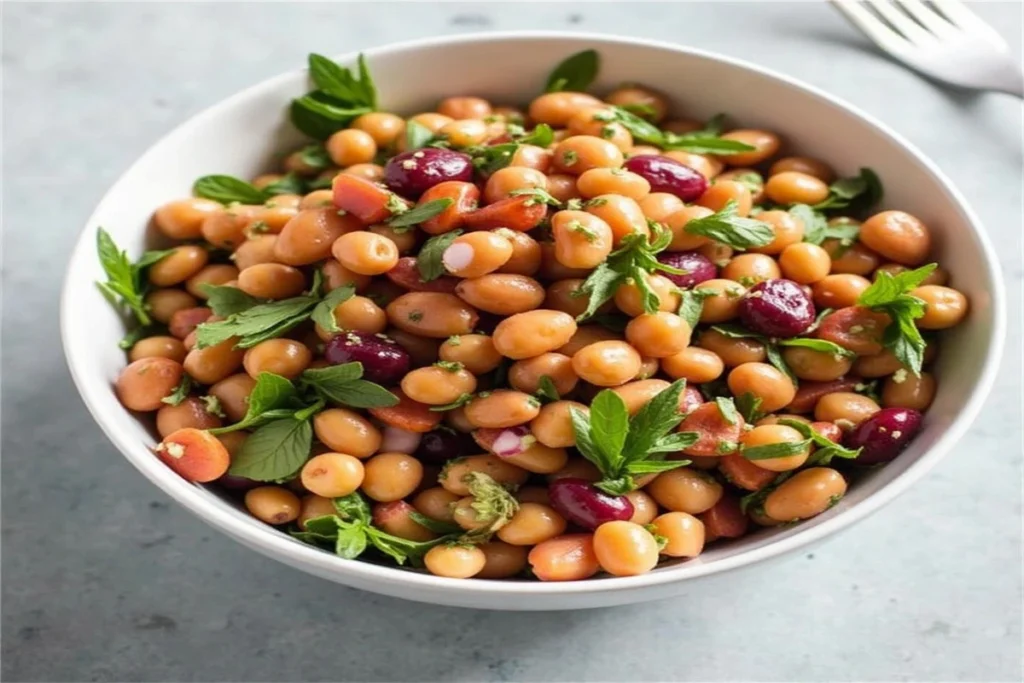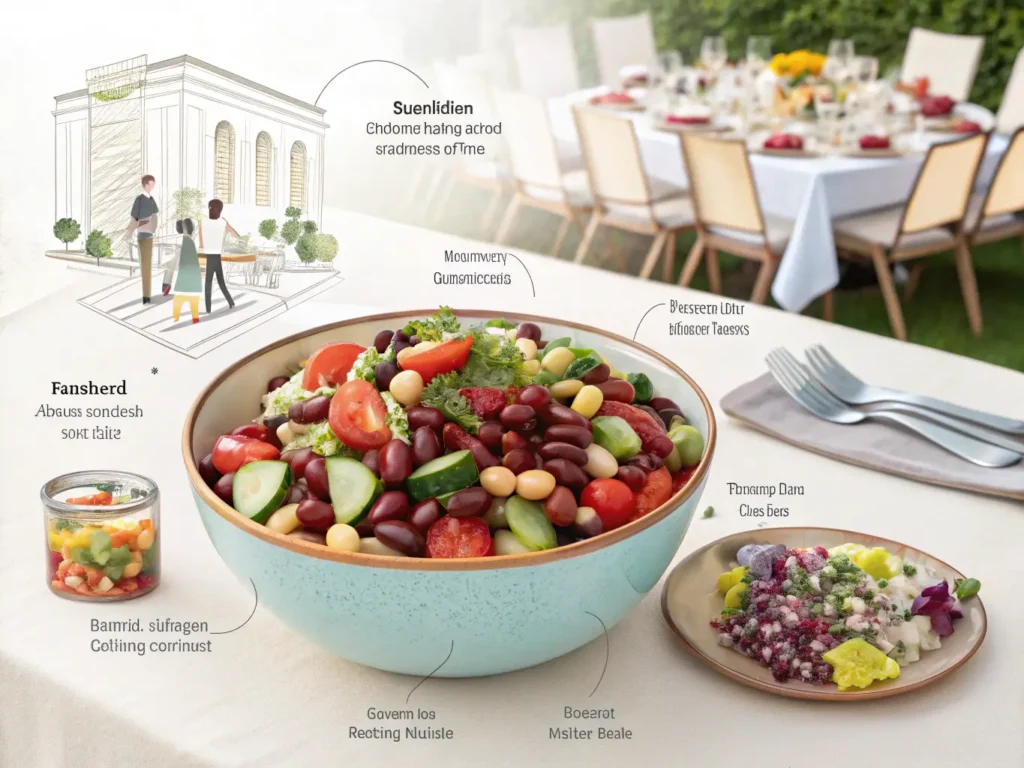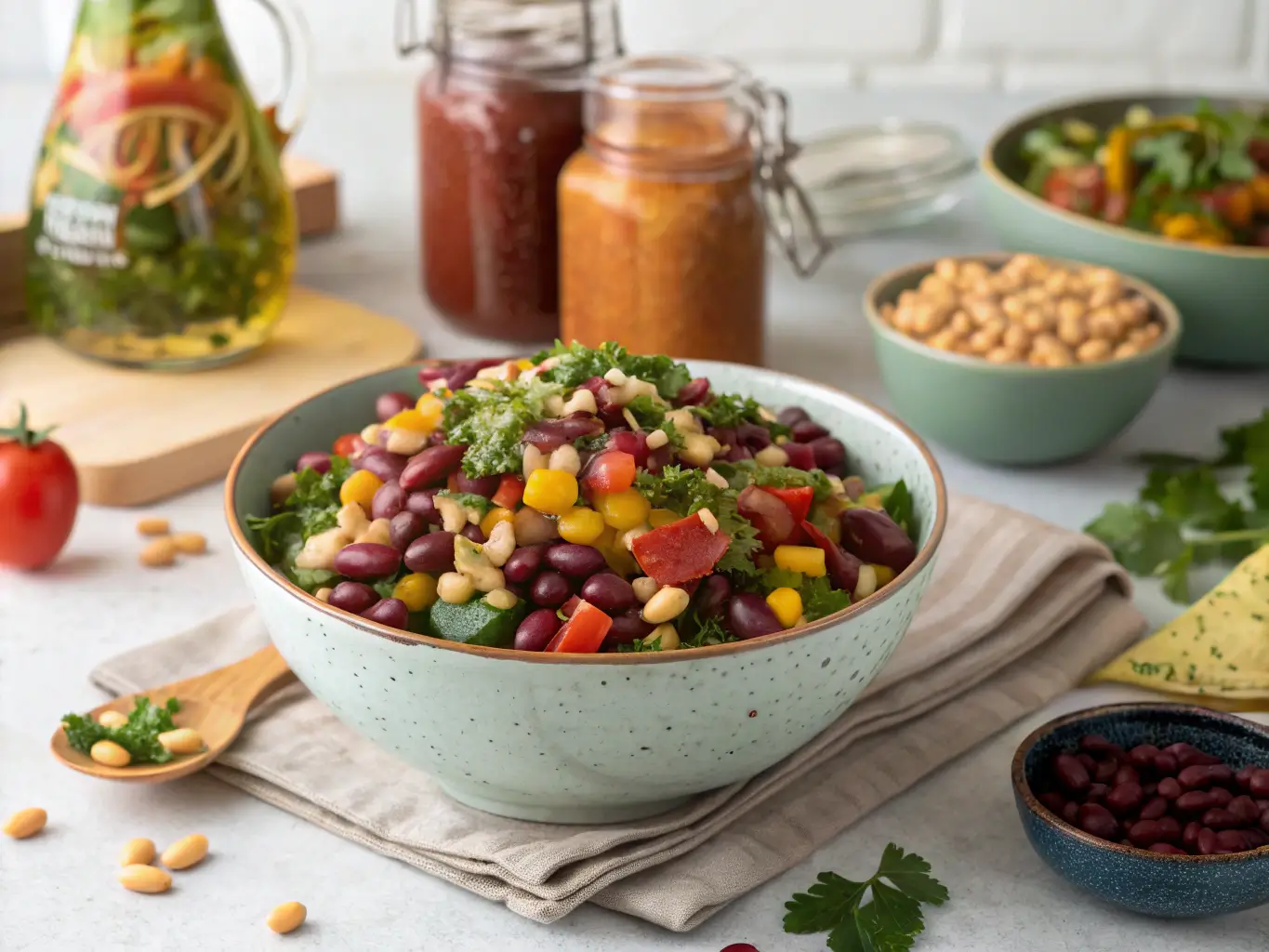Dense bean salad recipes capture the rich flavor and deep nutrition of legumes. They are perfect for quick lunches, outdoor gatherings, or weeknight family dinners. Indeed, these salads provide a higher level of protein and fiber than most grain-based dishes. Consequently, they satisfy hunger for hours and support balanced eating habits. Meanwhile, they adapt beautifully to various dietary preferences. Accordingly, both vegans and omnivores appreciate their wholesome composition. Furthermore, their versatility allows you to incorporate different spices, vegetables, and dressings to create vibrant, personalized dishes that never get boring.
What Makes Dense Bean Salad Recipes So Special?
Dense bean salads stand apart from simpler side dishes because of their thick, hearty texture. Basically, they use different legumes such as kidney beans, black beans, and chickpeas to create a filling meal. Particularly, the combination of beans ensures that these salads feel substantial and energy-dense.
Moreover, the richness of legumes pairs well with crisp vegetables, fragrant herbs, and tangy dressings. Altogether, this creates a balanced array of flavors and textures. Comparatively, other salads may leave you hungry soon after you eat. Conversely, these bean-based dishes leave you satisfied for much longer.
PrintDense Bean Salad Recipes
- Total Time: 15 min
- Yield: 6 servings 1x
- Diet: Vegan
Description
This hearty bean salad is loaded with plant-based protein and fiber from a trio of beans, colorful veggies, and a tangy vinaigrette. A satisfying, nutrient-dense dish that holds up beautifully for meal prep.
Ingredients
- 1 can (15 oz) chickpeas, drained and rinsed
- 1 can (15 oz) black beans, drained and rinsed
- 1 can (15 oz) kidney beans, drained and rinsed
- 1 red bell pepper, diced
- 1 cup cherry tomatoes, halved
- 1/2 red onion, finely chopped
- 1/2 cup chopped fresh parsley
- 1/4 cup olive oil
- 2 tbsp red wine vinegar
- 1 tbsp lemon juice
- 1 tsp Dijon mustard
- 1 garlic clove, minced
- Salt and black pepper to taste
Instructions
- 1. In a large bowl, combine chickpeas, black beans, kidney beans, bell pepper, tomatoes, red onion, and parsley.
- 2. In a small jar or bowl, whisk together olive oil, red wine vinegar, lemon juice, Dijon mustard, garlic, salt, and pepper.
- 3. Pour the dressing over the salad and toss well to coat.
- 4. Let sit for at least 20 minutes to allow flavors to blend. Refrigerate if prepping ahead.
- 5. Serve chilled or at room temperature. Mix again before serving.
Notes
- Customize with extras like avocado, cucumber, corn, or feta.
- Stores well in the fridge for up to 4 days great for lunchboxes or picnics.
- For extra protein, add grilled chicken or tuna.
- Prep Time: 15 min
- Cook Time: 0 min
- Category: Salad
- Method: No-Cook
- Cuisine: Mediterranean
Nutrition
- Serving Size: 1 cup
- Calories: 250
- Sugar: 3g
- Sodium: 320mg
- Fat: 10g
- Saturated Fat: 1.5g
- Unsaturated Fat: 8.5g
- Trans Fat: 0g
- Carbohydrates: 32g
- Fiber: 10g
- Protein: 10g
- Cholesterol: 0mg
Keywords: dense bean salad, high protein salad, fiber rich recipe, healthy bean salad, meal prep salad
Why Dense Bean Salad Recipes Are Perfect for Meal Preps
Preparing dense bean salad recipes in advance saves time and ensures you always have a nutritious option on hand. Indeed, many of these recipes keep well in the refrigerator for several days. Consequently, you can enjoy them throughout the week without losing quality. Meanwhile, beans soak up the dressing over time, making them taste even better after a day or two.
Generally, these salads require minimal cooking, as you often just rinse and drain canned beans and chop some vegetables. Hence, you can prepare large batches quite easily. Furthermore, meal-prepping dense bean salads ensures that your packed lunches are always nourishing and appealing. Nevertheless, you have room to customize flavors so that your salads feel fresh and exciting.
Selecting the Right Legumes for Dense Bean Salad Recipes
Choosing the right legumes influences both texture and flavor. Dense bean salad recipes usually start with black beans, kidney beans, or cannellini beans. However, experimenting with chickpeas, lentils, or even edamame can add variety.
Particularly, mixing different types of beans creates a visually appealing, colorful salad that pleases the palate. Moreover, consider the creaminess of cannellini beans or the slightly firmer bite of kidney beans. Equally, look for beans that hold their shape well, so the salad remains pleasantly textured rather than mushy.
Indeed, high-quality canned beans are convenient and reliable. Nevertheless, cooking your own beans from scratch allows for more control over texture. Subsequently, you can achieve a perfect tender-but-not-mushy consistency that elevates the entire dish.
Storing and Serving for Freshness
Proper storage ensures your dense bean salad recipes taste fresh and delicious. Basically, keep the salad in an airtight container and store it in the refrigerator for up to four days. Meanwhile, consider waiting to add fresh herbs and delicate greens until just before serving, so their flavors stay bright.
Furthermore, give your salad a gentle toss to redistribute the dressing and any settling juices. Occasionally, add a pinch of salt or a squeeze of citrus if the flavors need a boost. Another trick involves storing the dressing separately and tossing right before serving. Comparatively, if you prefer a salad that becomes more flavorful with time, dress it in advance.
Pairing with Complementary Dishes
Dense bean salad recipes shine as standalone meals, but pairing them with other dishes can create a full feast. Consequently, serve them alongside grilled chicken, roasted fish, or baked tofu for added protein. Furthermore, warm whole-grain bread or fluffy pita complements the salads’ hearty nature. Additionally, fresh fruit salads or roasted vegetables provide contrast and variety.
Similarly, consider pairing these bean salads with tangy yogurt sauces or creamy guacamole for extra richness. Equally appealing are crunchy seed toppings or toasted nuts that deliver extra texture. Undoubtedly, these thoughtful pairings transform a simple bean salad into a balanced, memorable spread. Therefore, do not hesitate to get creative and test different flavor matches that suit your personal preferences.

How to Customize Dense Bean Salad Recipes for Different Dietary Needs
Dense bean salad recipes adapt seamlessly to various diets. For instance, vegans and vegetarians find beans an excellent source of protein and iron. Consequently, these salads fit right into a plant-based meal plan. Meanwhile, those following a gluten-free diet can rely on legumes instead of grains, ensuring a satisfying meal that avoids wheat-based products. Moreover, low-carb variations might replace starchy legumes with slightly lower-carb beans like black soybeans.
Additionally, those concerned with sodium intake can choose low-salt beans and seasonings. Comparatively, if you follow a Mediterranean-style diet, include olives, fresh herbs, and extra-virgin olive oil. Conversely, for a Southwestern twist, add diced jalapeños, fresh cilantro, and lime juice.
Adding More Vegetables to Dense Bean Salad Recipes for Extra Nutrients
Vegetables elevate dense bean salad recipes, adding color, nutrients, and complexity. Basically, crunchy bell peppers, crisp cucumbers, and sweet cherry tomatoes contribute contrasting textures. Meanwhile, shredded carrots or sliced radishes add a peppery bite. Furthermore, leafy greens like spinach or kale bring freshness and minerals. Likewise, finely chopped red onion or scallions impart subtle spice and aroma.
Consequently, these vegetable additions boost the fiber and vitamins in your dish. Another approach involves roasting or grilling some vegetables such as zucchini, eggplant, or mushrooms, to impart smoky depth. In any case, adding more vegetables diversifies both flavor and nutrition, ultimately delivering a more balanced and satisfying meal.
Incorporating Whole Grains into Dense Bean Salad Recipes for Complete Nutrition
Dense bean salads thrive with whole grains for extra heartiness. Add chewy farro, nutty quinoa, or fluffy brown rice to provide a substantial base. Subsequently, the combination of legumes and grains creates a complete protein profile, an asset for plant-based eaters. Basically, grains help tie all the flavors together and make the dish even more filling.
Moreover, grains absorb the dressing beautifully, ensuring every bite bursts with taste. Meanwhile, those seeking a lighter option can skip the grains entirely and focus on the beans and vegetables. However, incorporating grains often adds complexity, turning a simple side salad into a main course. Consequently, you expand the recipe’s versatility and ensure it meets your dietary needs.

Top Flavor Enhancements for Dense Bean Salad Recipes
Flavor is key to making dense bean salad recipes memorable. Indeed, these simple yet robust dishes rely heavily on dressing and seasonings. Consequently, try drizzling high-quality olive oil and a splash of vinegar or citrus juice. Moreover, mustard, tahini, or yogurt-based dressings can bring creaminess.
Additionally, dried herbs like oregano, thyme, or marjoram complement savory beans. Meanwhile, fresh herbs like basil, cilantro, parsley, or dill add brightness and fragrance. Furthermore, consider adding grated garlic, lemon zest, or chili flakes for a kick. Consequently, layering flavors ensures your salad stands out.
Balancing Acidity and Sweetness in Dense Bean Salad Recipes
Proper balance of flavors sets dense bean salad recipes apart. Undoubtedly, acidity and sweetness both play critical roles. Acidity, from vinegar or citrus juice, brightens flavors and cuts through richness. Conversely, a hint of sweetness, possibly from a drizzle of honey or a pinch of sugar, can round out tart edges.
Essentially, these opposing tastes create a dynamic profile that keeps your palate engaged. Indeed, finding the right ratio requires experimentation. Eventually, you discover that a splash of lime juice pairs well with a bit of maple syrup, or apple cider vinegar works nicely with a touch of agave. .
Using Fresh and Dried Herbs in Dense Bean Salad Recipes
Herbs enliven dense bean salad recipes, providing complexity and aroma. Basically, fresh herbs like basil and cilantro deliver bright, green notes. Meanwhile, dried herbs like oregano or thyme add depth and warmth. Additionally, mixing fresh and dried herbs creates a layered flavor profile that evolves with each bite.
Specifically, try pairing parsley with dried oregano, or fresh dill with dried tarragon. Moreover, adjusting herb combinations can shift the salad’s overall theme. For example, basil and oregano give an Italian flair, while cilantro and lime evoke Latin American influences. Comparatively, using dill and lemon zest steers the flavor towards a Mediterranean profile.
Creating Dense Bean Salad Recipes That Appeal to the Senses
Appealing to sight, smell, and taste sets these salads apart. Initially, the colorful mix of beans and vegetables captures attention. Meanwhile, fresh herbs and spices release fragrant aromas that stimulate appetite. Furthermore, a creamy dressing or a sprinkle of nuts adds textural contrast. Consequently, achieving a dish that pleases all senses enhances the overall eating experience.
Generally, our senses guide our perception of flavor, so focusing on visual appeal, aromatic herbs, and textural variety contributes to a more satisfying meal. Accordingly, you create salads that taste as vibrant as they look. Indeed, when every element harmonizes, your bean salad becomes a memorable dish you will want to share with family and friends.
Adapting Dense Bean Salad Recipes for Different Occasions
Dense bean salad recipes fit comfortably into various events and celebrations. For instance, serve them at potlucks or picnics, where their easy portability and shelf stability shine. Additionally, bring them to work gatherings as a crowd-pleasing option that accommodates many dietary restrictions. Meanwhile, consider dressing them up for more formal occasions.
Add a touch of truffle oil, edible flowers, or artisanal cheeses for a gourmet twist. Conversely, keep it simple for a casual weekend lunch. In any scenario, bean salads excel because they are both practical and elegant. Furthermore, they travel well, require minimal last-minute assembly, and taste great at room temperature. Consequently, you can rely on them for convenience, versatility, and impressive presentation.

Cultural Inspirations in Dense Bean Salad Recipes
Dense bean salad recipes are incredibly versatile and often reflect global cuisines. Basically, the choice of beans, herbs, and seasonings can represent different food cultures. For example, Mediterranean-inspired salads might use chickpeas, olives, and feta. Meanwhile, a Latin American version could feature black beans, corn, and cilantro-lime dressing.
Likewise, Middle Eastern variations might include lentils, parsley, mint, and tahini-based dressings. Accordingly, each cultural twist brings unique flavors and textures. Generally, exploring global influences introduces new taste combinations and cooking methods. Therefore, do not hesitate to try new herb blends, spices, and sauces. Eventually, you develop a repertoire of bean salads that celebrate culinary traditions worldwide.
Practical Tips for Perfect Dense Bean Salad Recipes
Achieving the best possible bean salad involves attention to detail. Initially, rinse and drain canned beans thoroughly to remove excess sodium and improve taste. Additionally, consider marinating your beans in the dressing before adding other ingredients, so flavors fully penetrate. Furthermore, chop vegetables into consistent, bite-sized pieces. This ensures an even distribution of textures and flavors.
Occasionally, taste-test as you go, adjusting seasonings or acidity until you reach the desired balance. Moreover, allow the salad to rest before serving, giving flavors time to meld. Another tip involves experimenting with different oils, vinegars, and citrus juices to discover your personal favorites. Ultimately, these small adjustments add up, resulting in salads that consistently impress.
Sustainability and Sourcing of Ingredients
The beans in dense bean salad recipes often have a lower environmental impact compared to animal proteins. Consequently, you support sustainable eating habits by incorporating more legumes. Consider sourcing your beans from local farms or using certified-organic brands that value environmental stewardship.
Meanwhile, look for seasonal vegetables from farmers’ markets, ensuring peak freshness and flavor. Furthermore, choosing high-quality olive oil or vinegar can boost both taste and sustainability. Indeed, mindful ingredient selection not only enhances the final dish but also aligns your cooking habits with responsible environmental practices.
Comparatively, plant-based salads generally have a smaller carbon footprint than meat-centric meals. Thus, embracing bean salads contributes to a more sustainable way of eating.
Serving Dense Bean Salad Recipes to Picky Eaters and Children
Picky eaters often appreciate dense bean salad recipes once you adjust flavors and textures. Basically, start with mild beans like cannellini and add familiar vegetables such as cherry tomatoes or cucumber. Meanwhile, a light, slightly sweet dressing may help ease kids into enjoying the salad.
Furthermore, serve the dish as a colorful side, highlighting the beans’ fun shapes and bright colors. Eventually, children may start to appreciate new ingredients. Another approach involves involving them in the preparation, letting them choose which beans or veggies to include. This engagement can spark curiosity and broaden their palates. Over time, even hesitant eaters may embrace bean salads as a regular part of their meals.
Frequently Asked Questions (FAQs)
Why are dense bean salads good for you?
Dense bean salads are rich in protein, fiber, vitamins, and minerals. Consequently, they support digestive health, boost energy, and help maintain muscle mass. Additionally, their combination of legumes, vegetables, and healthy fats contributes to balanced nutrition and sustained fullness. Therefore, they are a smart choice for anyone seeking a nutrient-dense meal.
Why is it called dense bean salad?
They are called dense bean salads because they feature substantial amounts of legumes, resulting in a thick, hearty texture. Basically, the beans provide a denser bite than leafy greens alone. Accordingly, this density ensures that the salad feels more satisfying, making it a complete meal rather than a simple side.
What is a dense bean?
A dense bean refers to a legume that maintains a firm, substantial texture, such as kidney, chickpea, or black bean. Compared to other beans that become mushy when cooked, dense beans keep their shape and bite. Consequently, they are ideal for salads where texture matters. Indeed, these beans give the salad its characteristic heft and heartiness.
What is the healthiest beans to put in a salad?
Chickpeas, lentils, and black beans are popular choices due to their protein and fiber content. Additionally, kidney beans and cannellini beans provide iron and other essential minerals. Generally, variety ensures a wide range of nutrients. Therefore, mixing different beans boosts your salad’s overall nutritional value and flavor complexity.
Conclusion
Incorporating dense bean salad recipes into your routine offers a flavorful and wholesome solution for nourishing meals. These hearty salads deliver ample protein, fiber, and essential nutrients, while adapting easily to various dietary preferences. Whether enjoyed as a standalone dish or paired with complementary sides, dense bean salads consistently impress with their texture, taste, and versatility. By adjusting seasonings, ingredients, and cultural influences, you can continuously reinvent your salad, ensuring it remains both healthful and exciting. Over time, these salads become reliable go-to options that simplify your meal planning, help you maintain balanced nutrition, and keep you looking forward to every delicious bite.
Want more protein-packed treats? Don’t miss our Carrot Cake Cookies Recipe: The Perfect Chewy Treat for Every Season.

